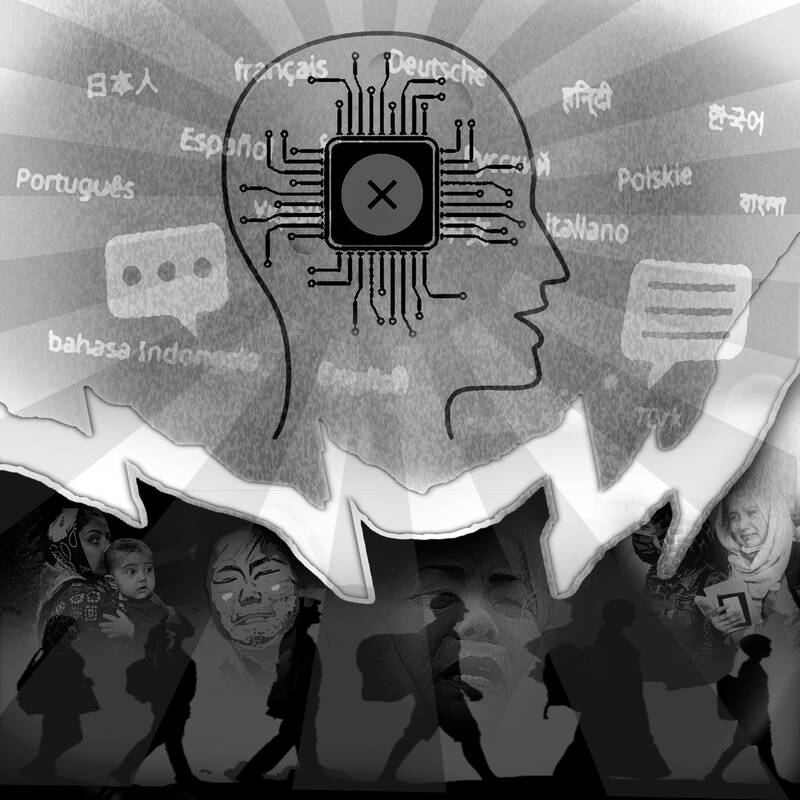Names translated as months of the year, incorrect time frames and mixed-up pronouns — the everyday failings of artificial intelligence-driven (AI) translation apps are causing havoc in the US asylum system, critics say.
“We have countless examples of this nature,” said Ariel Koren, founder of Respond Crisis Translation, a global collective that has translated more than 13,000 asylum applications, warning that errors can lead to unfounded denials.
In one case, she said, attorneys missed a crucial detail in a woman’s account of domestic abuse because the translation app they were using kept breaking down, and they ran out of time.

Illustration: Kevin Sheu
“The machines themselves are not operating with even a fraction of the quality they need to be able to do case work that’s acceptable for someone in a high-stakes situation,” said Koren, who used to work for Google Translate.
She told the Thomson Reuters Foundation that a translator with the group had estimated that 40 percent of Afghan asylum cases he had worked on had encountered problems due to machine translation. Cases involving Haitian Creole speakers have also faced significant issues, she added.
Government contractors and large aid organizations are increasingly using AI machine translation tools due to “an immense amount of incentive to cut costs,” Koren said.
The extent to which such tools are being used in US immigration processing is unclear amid a broad lack of transparency, said Aliya Bhatia, a policy analyst with the Center for Democracy & Technology think tank.
“We know governments and asylum lobbies around the world ... are moving toward using automated technology,” Bhatia said.
A 2019 report from investigative news outlet ProPublica found that immigration officials were being directed to use Google Translate to “vet” social media use for refugee applications.
The US Department of Justice, and the Immigration and Customs Enforcement agency did not respond to requests for comment, nor did the White House, which recently released a national “blueprint” on AI guidelines.
Asked about concerns over the use of machine translation in asylum cases, a spokesperson for Google said its Google Translate tool underwent strict quality controls and pointed out that it was offered free of charge.
“We rigorously train and test our systems to ensure each of the 133 languages we support meets a high standard for translation quality,” the spokesperson said.
A major shortcoming of translation tools’ use in asylum cases stems from the difficulty of building in checks, said Gabe Nicholas, a research fellow with the Center for Democracy & Technology and coauthor with Bhatia of a paper on the models being used for machine translation.
“Because the person speaks only one language, the potential for mistakes and errors to go uncaught is really, really high,” he said.
Machine translation has made significant progress in recent years, Nicholas and Bhatia said, adding that it is still nowhere near good enough to be relied upon in often complex, high-stakes situations such as the asylum process.
A core problem is how the apps are trained in the first place — on digitized text, for which there are masses available for English, but far less for other languages.
This not only results in less nuanced or simply incorrect translations, but it also means English or some other high-resource languages become “intermediaries though which these models view the world,” Bhatia said.
The result is Anglocentric translations that often fail to accurately capture crucial details around a particular word.
Like many other sectors, the translation industry has been upended in recent months by the release of “generative” AI tools such as ChatGPT.
“ChatGPT and AI are now on everybody’s minds,” said Jill Kushner Bishop, founder and CEO of Multilingual Connections, a company based in the Chicago area.
“There are cases for it, and those are more and more compelling all the time. But it’s still not ready in most cases to be used with the training wheels off and without a human involved,” Bishop said.
The company does regular testing of tools and different languages, production director Katie Baumann said, but continues to find problems with text translations involving, say, Turkish or Japanese, or AI-driven audio transcriptions with background noise.
“We’ve run tests of extracts of law enforcement interviews, processing and putting it through machine translation — a lot of it is nonsense. It wouldn’t save you any time, so we wouldn’t use it,” Baumann said.
So even as Multilingual Connections does increasingly use machine translation, a human is always involved.
“You don’t know what you don’t know. So for someone who is not a speaker of the language ... you don’t know where the mistakes will be,” Bishop said.
“Think about asylum cases ... and what might be misunderstood without a human verifying,” she said.
OpenAI, which developed ChatGPT, declined to comment, but a spokesperson pointed to policies that bar use for “high-risk government decisionmaking” including law enforcement, criminal justice, migration and asylum.
At Respond Crisis Translation, the shortcomings of AI-driven translation tools are also creating an extra layer of work for Koren and her colleagues.
“The people who need to clean up the mess are human translators,” she said.
One of the collective’s translators, Samara Zuza, has been working for three years with a Brazilian asylum seeker whose asylum papers were poorly translated by an AI app while he was in immigration detention in California, she said.
The application was “full of insane mistakes,” Zuza said. “The names of the city and state are wrong. The sentences are reversed — and that’s the form that was sent to the court.”
She thinks it was these inaccuracies that resulted in the rejection of initial attempts to secure the man’s release. The man, who asked to be identified only as Carlos, a pseudonym, was eventually released in May 2020 after the two started working together.
“The language was the worst aspect for me,” Carlos, 49, said of his six months in immigration detention after he fled gang activity in Brazil.
He spoke by phone from Massachusetts, where he is now living as he applies for US residency.
Carlos, who is illiterate and speaks Brazilian Portuguese, said he had been unable to communicate with immigration officials or even other detainees for months.
To fill out his asylum paperwork, he relied on a tablet computer’s voice recorder coupled with an app that used machine translation.
“So many of the words were being wrongly translated,” he said. “My asylum papers were a terrible mess.”
Lockheed Martin on Tuesday responded to concerns over delayed shipments of F-16V Block 70 jets, saying it had added extra shifts on its production lines to accelerate progress. The Ministry of National Defense on Monday said that delivery of all 66 F-16V Block 70 jets — originally expected by the end of next year — would be pushed back due to production line relocations and global supply chain disruptions. Minister of National Defense Wellington Koo (顧立雄) said that Taiwan and the US are working to resolve the delays, adding that 50 of the aircraft are in production, with 10 scheduled for flight

Victory in conflict requires mastery of two “balances”: First, the balance of power, and second, the balance of error, or making sure that you do not make the most mistakes, thus helping your enemy’s victory. The Chinese Communist Party (CCP) has made a decisive and potentially fatal error by making an enemy of the Jewish Nation, centered today in the State of Israel but historically one of the great civilizations extending back at least 3,000 years. Mind you, no Israeli leader has ever publicly declared that “China is our enemy,” but on October 28, 2025, self-described Chinese People’s Armed Police (PAP) propaganda
On Sunday, 13 new urgent care centers (UCC) officially began operations across the six special municipalities. The purpose of the centers — which are open from 8am to midnight on Sundays and national holidays — is to reduce congestion in hospital emergency rooms, especially during the nine-day Lunar New Year holiday next year. It remains to be seen how effective these centers would be. For one, it is difficult for people to judge for themselves whether their condition warrants visiting a major hospital or a UCC — long-term public education and health promotions are necessary. Second, many emergency departments acknowledge
Chinese Consul General in Osaka Xue Jian (薛劍) on Saturday last week shared a news article on social media about Japanese Prime Minister Sanae Takaichi’s remarks on Taiwan, adding that “the dirty neck that sticks itself in must be cut off.” The previous day in the Japanese House of Representatives, Takaichi said that a Chinese attack on Taiwan could constitute “a situation threatening Japan’s survival,” a reference to a legal legal term introduced in 2015 that allows the prime minister to deploy the Japan Self-Defense Forces. The violent nature of Xue’s comments is notable in that it came from a diplomat,